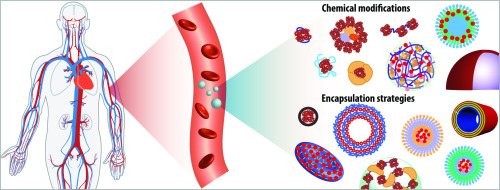Advances in Colloid and Interface Science ( IF 15.6 ) Pub Date : 2018-08-24 , DOI: 10.1016/j.cis.2018.08.006 Michelle M.T. Jansman , Leticia Hosta-Rigau

|
Blood transfusions, which usually consist in the administration of isolated red blood cells (RBCs), are crucial in traumatic injuries, pre-surgical conditions and anemias. Although RBCs transfusion from donors is a safe procedure, donor RBCs can only be stored for a maximum of 42 days under refrigerated conditions and, therefore, stockpiles of RBCs for use in acute disasters do not exist. With a worldwide shortage of donor blood that is expected to increase over time, the creation of oxygen-carriers with long storage life and compatibility without typing and cross-matching, persists as one of the foremost important challenges in biomedicine.
However, research has so far failed to produce FDA approved RBCs substitutes (RBCSs) for human usage. As such, due to unacceptable toxicities, the first generation of oxygen-carriers has been withdrawn from the market. Being hemoglobin (Hb) the main component of RBCs, a lot of effort is being devoted in assembling semi-synthetic RBCS utilizing Hb as the oxygen-carrier component, the so-called Hb-based oxygen carriers (HBOCs). However, a native RBC also contains a multi-enzyme system to prevent the conversion of Hb into non-functional methemoglobin (metHb). Thus, the challenge for the fabrication of next-generation HBOCs relies in creating a system that takes advantage of the excellent oxygen-carrying capabilities of Hb, while preserving the redox environment of native RBCs that prevents or reverts the conversion of Hb into metHb. In this review, we feature the most recent advances in the assembly of the new generation of HBOCs with emphasis in two main approaches: the chemical modification of Hb either by cross-linking strategies or by conjugation to other polymers, and the Hb encapsulation strategies, usually in the form of lipidic or polymeric capsules. The applications of the aforementioned HBOCs as blood substitutes or for oxygen-delivery in tissue engineering are highlighted, followed by a discussion of successes, challenges and future trends in this field.
中文翻译:

纳米和微体系结构作为基于血红蛋白的氧气载体的最新且著名的例子
输血通常包括施用离体的红细胞(RBC),对创伤,手术前状况和贫血至关重要。尽管从供体中输注红细胞是安全的程序,但在冷藏条件下最多只能将供体红细胞存储42天,因此,不存在用于急性灾害的红细胞库存。随着世界范围内供血的短缺,随着时间的流逝,这种缺氧的产生将继续存在,这是生物医学面临的最重要的挑战之一,它是一种具有长期保存期限和相容性而又无需分型和交叉匹配的载氧体。
但是,到目前为止,研究仍未能生产出FDA批准的RBC替代品(RBCS)供人类使用。因此,由于不可接受的毒性,第一代氧气载体已经从市场上撤出。作为血红蛋白(Hb)的主要成分,人们正致力于用Hb作为氧气载体成分,即所谓的基于Hb的氧气载体(HBOC)组装半合成RBCS。但是,天然RBC也包含多酶系统,以防止Hb转化为非功能性高铁血红蛋白(metHb)。因此,制造下一代HBOC的挑战在于创建一个系统,该系统利用Hb的出色携氧能力,同时保留天然RBC的氧化还原环境,以防止或将Hb转化为metHb。在这篇评论中,我们介绍了新一代HBOC组装的最新进展,重点介绍了两种主要方法:通过交联策略或与其他聚合物的结合对Hb进行化学修饰,以及Hb包封策略,通常采用以下形式脂质或聚合物胶囊。重点介绍了上述HBOC作为血液替代品或在组织工程中用于氧气输送的应用,然后讨论了该领域的成功,挑战和未来趋势。


























 京公网安备 11010802027423号
京公网安备 11010802027423号